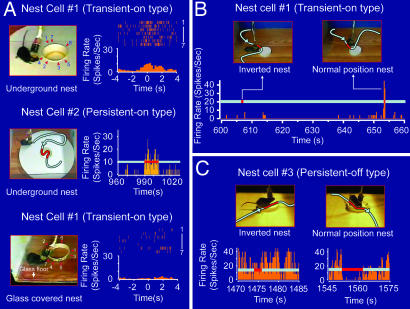Fig. 5.
The responses of nest cells are tuned toward the functionality of nests. (A) Cell #1 of mouse A responded significantly to an underground nest (Top), as did Cell #2 of mouse B (Middle). The nest cell would no longer respond to a nest covered by a glass floor, indicating the importance of physical interactions (Bottom). (B) Cell #1 did not respond to the plastic nest that was placed in an inverted manner (as a small stage) (Left). Interestingly, once the plastic nest was reverted back to its normal position (Right), the cell exhibited robust firing up to 40 Hz. The recorded spike discharge pattern during this 1-min “nest manipulation” period is shown. (C) The nest cell #3 of mouse C did not reduce its firing when mouse C crossed over the inverted plastic nest (functions as a small stage). However, once the plastic cap was flipped back into a nest position, the cell ceased to fire (average of 0.72 Hz) from an average basal level of 19.06 Hz when the mouse crossed over the plastic cap. The gray lines in B and C illustrate the animal's movement paths, and the red segments indicate the duration in which mouse A was approaching the nest (B) or mouse C moved inside the nest (C). Also, please see representative movie clips of A–C in SI Movies 1–3.

